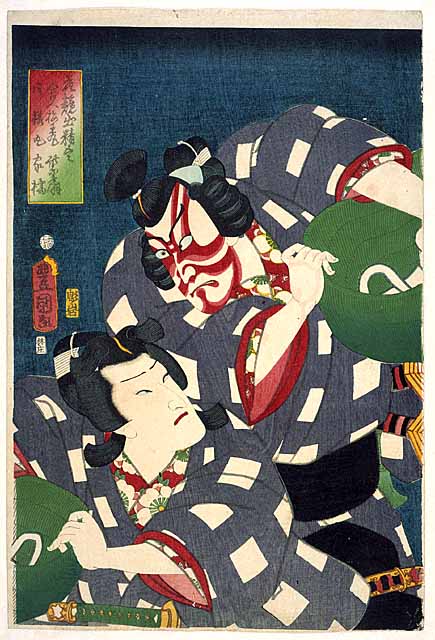Sakuramaru and Umeomaru

(Image and information from Fitzwilliam Museum <http://www.fitzmuseum.cam.ac.uk/gallery/japan/gallery/textp86.htm>)
Kawarazaki Shisen (Kawarazaki Gonjuro I ) as Umeomaru and Ichimura Kakitsu (Ichimura Uzaemon XIII) as Sakuramaru in Sugawara denju tenarai kagami (Sugawara and the secrets of calligraphy) performed at the Ichimura theatre from 10/17/1861.
From the set entitled 'Series Comparing the Diligence of Young Flowers' ( Hana-kurabe shussei-zukushi ), published 11/1861. Kunisada designed several prints in connection with this performance.
This print depicts two of the triplets in the scene called Kuruma Biki (Pulling the Carriage Apart) in which they confront their triplet brother Matsuomaru who serves their enemy Shihei (AKA Fujiwara Tokihira). They each wear a thick padded dotera kimono with a pattern of large purple and white squares ( soshigoshi ). They hold the green wicker hats ( amigasa ) that they have just removed, revealing their faces. Sakuramaru is the more elegant figure with subtle eye make-up known as mukimi ('trough-shell shadows') and divided forelock wig called mae jasen ('front-facing tea whisk'); his more gentle role is traditionally played in a slightly effeminate manner ( wakashugata ). In contrast Umeomaru is one of the prime examples of the aragoto ('rough-stuff') style of acting, with appropriately fierce red make-up with extra shadow lines ( nihon suji guma ), and extravagant wig with high pom-pom and spoke-like projections on either side, known as the kuruma bin (carriage sidelocks). For this scene he wore muscular body 'make-up', visible on his hands and arms, which was actually dyed onto white silk skin-garments. Aragoto roles were particularly associated with the Danjuro lineage of actors.